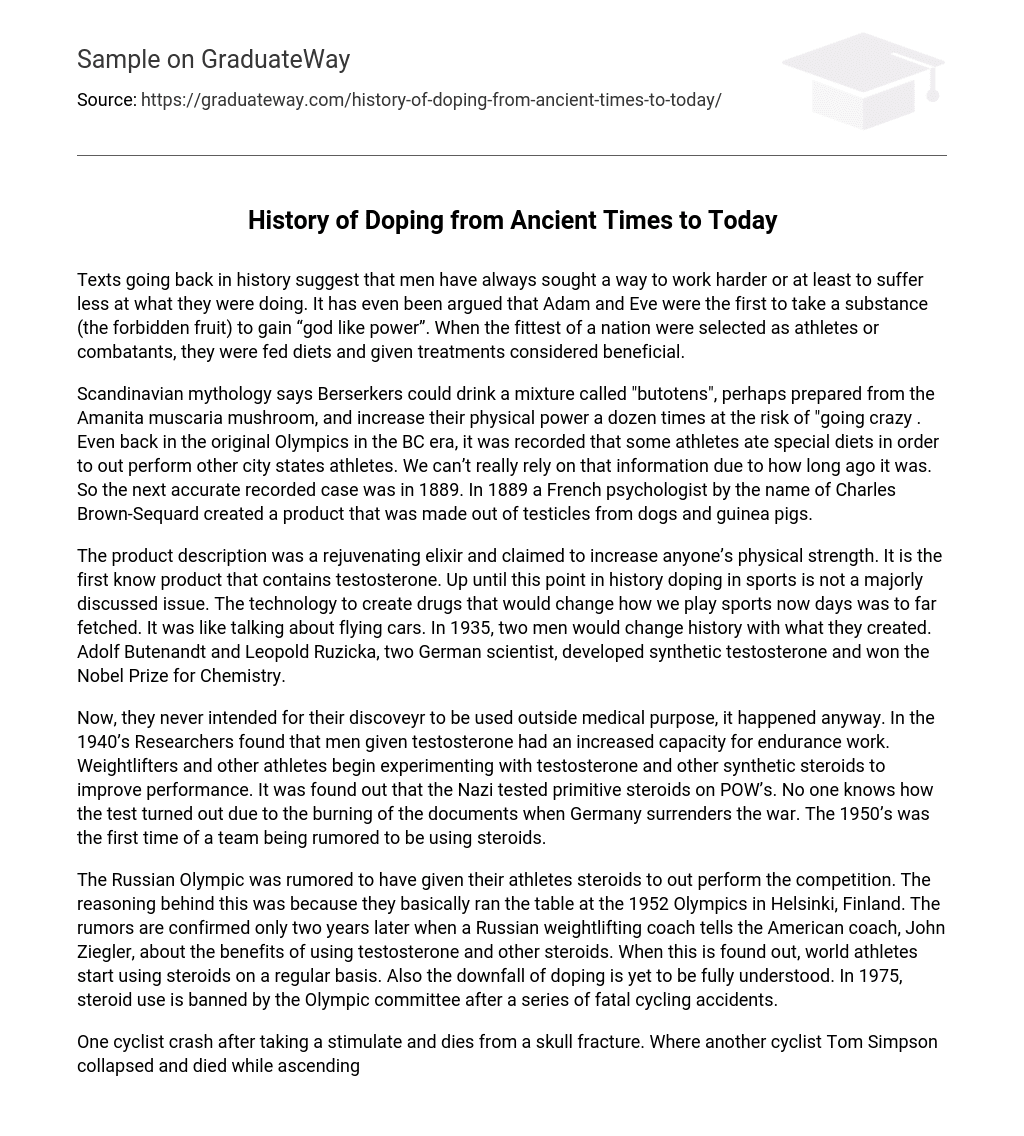Throughout history, men have always sought to enhance their productivity and alleviate suffering in the workplace. It is even suggested that Adam and Eve were the first to partake of a forbidden fruit with the intention of gaining divine abilities. In societies where the most skilled individuals were selected as athletes or warriors, they were given nourishing meals and therapeutic treatments believed to be beneficial.
In Scandinavian mythology, Berserkers were believed to enhance their physical power by consuming a mixture called “butotens,” potentially made from the Amanita muscaria mushroom. However, this came with the risk of losing one’s sanity. Similarly, even in the ancient Olympics during the BC era, some athletes reportedly followed special diets to outperform athletes from other city-states. Unfortunately, relying on this information is challenging due to its antiquity. The next accurately recorded case occurred in 1889 when a French psychologist named Charles Brown-Sequard developed a product using testicles from dogs and guinea pigs.
The product description advertised an rejuvenating elixir that supposedly boosts physical strength. It is noteworthy for being the first known product to contain testosterone. Prior to this time, doping in sports was not a widely debated topic as the technology to create performance-enhancing drugs seemed like a distant possibility, akin to discussing flying cars. Nonetheless, in 1935, two German scientists named Adolf Butenandt and Leopold Ruzicka managed to develop synthetic testosterone and were awarded the Nobel Prize in Chemistry, thereby changing the course of history.
Despite not intending for their discovery to be used for non-medical purposes, researchers discovered in the 1940s that men who were given testosterone experienced an increase in endurance. This finding led weightlifters, athletes, and even the Nazi regime to experiment with testosterone and other synthetic steroids in order to enhance performance. Unfortunately, the outcomes of the Nazi’s tests on prisoners of war remain unknown due to the burning of documents when Germany surrendered in the war. By the 1950s, rumors began circulating about teams using steroids for the first time.
The Russian Olympic team was rumored to have provided their athletes with steroids to outperform their competitors, which gained attention after their dominance in the 1952 Olympics in Helsinki, Finland. The truth emerged only two years later when a Russian weightlifting coach revealed to American coach John Ziegler the benefits of using testosterone and other steroids. This disclosure sparked widespread use of steroids among athletes globally; however, the negative effects were not fully understood at that time. It wasn’t until 1975, following a series of cycling accidents resulting in deaths, that the Olympic committee prohibited steroid usage.
The Tour de France is prompted to implement doping controls due to the death of a cyclist who suffered a skull fracture from taking a stimulant. Additionally, another cyclist named Tom Simpson collapses and dies while climbing Mont Ventoux during the Tour de France. This incident leads to the Olympic Committee adopting similar measures. Furthermore, in the 1980s, two new types of steroids are developed. In 1983, scientists successfully clone the gene for human erythropoietin (EPO), followed by the production of synthetic human growth hormone (HGH) in 1985.
The ban on the sale of anabolic steroids without a prescription in the United States is a result of various events. One such event occurred during the Olympic Games in Seoul, Korea, where Canadian sprinter Ben Johnson was stripped of his gold medal in the 100-meter race for testing positive for stanozolol, a steroid. In 1990, the NFL implemented year-round drug testing to discourage players from using steroids during their offseason. Moreover, in 1991, a federal law was passed that made it illegal to sell or possess anabolic steroids in the United States without a valid prescription from a doctor.
In 1998, several significant instances related to steroids occurred. Firstly, customs agents found 13 vials of HGH in the possession of a Chinese swimmer who arrived for the world championships. Additionally, vials of EPO were discovered in a car owned by the French Festina team during the Tour de France. Consequently, charges were brought against various riders and support crew members for doping, resulting in their suspension. Finally, Mark McGwire from the St. Louis Cardinals confessed to using androstenedione. In recent years, numerous reforms and policies have been put in place to effectively enforce the prohibition of steroids
In 2005, the NHL established a policy for testing performance-enhancing drugs. Players go through two tests annually and face varying consequences based on their results. A first offense leads to a 20-game suspension, while a second offense results in a 60-game suspension. A third offense results in a permanent ban, although players can request reinstatement after two years.
During this time, baseball player Jose Canseco disclosed his own use of steroids in his book “Juiced: Wild Times, Rampant ‘Roids, Smash Hits and How Baseball Got Big.” He also accused several MLB stars of using performance-enhancing drugs. These instances serve as significant moments in the history of steroids as they demonstrate how this industry has evolved over time and become one of the most complex occupations globally through the creation of synthetic hormones.
From my perspective, studying history allows us to learn from past mistakes. However, my research suggests that some individuals remain unaware of our limitations. While steroids may offer extraordinary strength or improved speed, achieving these results still necessitates traditional hard work. Ultimately, athletes who utilize steroids deceive both themselves and others.





